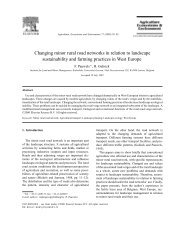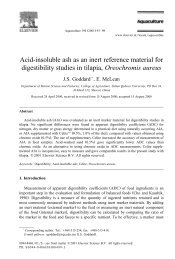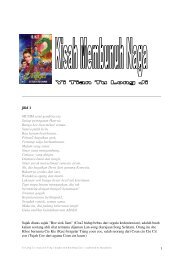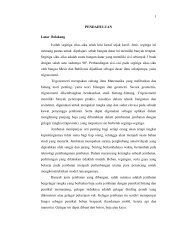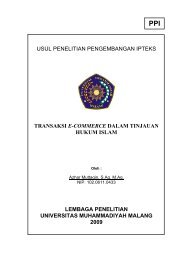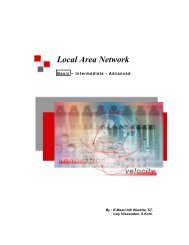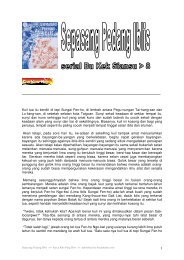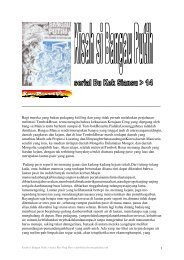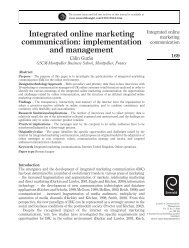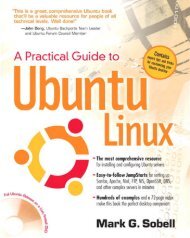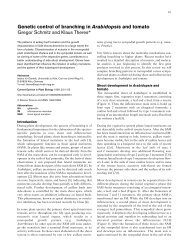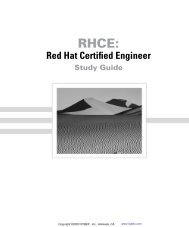Agar as a medium for removing soil from earthworm ... - Directory UMM
Agar as a medium for removing soil from earthworm ... - Directory UMM
Agar as a medium for removing soil from earthworm ... - Directory UMM
Create successful ePaper yourself
Turn your PDF publications into a flip-book with our unique Google optimized e-Paper software.
Short Communication<br />
<strong>Agar</strong> <strong>as</strong> a <strong>medium</strong> <strong>for</strong> <strong>removing</strong> <strong>soil</strong> <strong>from</strong> <strong>earthworm</strong> guts<br />
Andrei D. Pokarzhevskii a, *, Nico M. Van Straalen b , Alexander M. Semenov c<br />
a Institute of Ecology and Evolution of the Russian Academy of Sciences, 117071 Moscow, Leninsky prospect 33, Russian Federation<br />
b Institute of Ecological Science, Vrije Universiteit, De Boelelaan 1087, 1081 HV Amsterdam, The Netherlands<br />
c Institute of Microbiology of the Russian Academy of Sciences, 119336 Moscow, Prospect of the 60-Anniversary of October 5, Russian Federation<br />
Abstract<br />
Accepted 4 November 1999<br />
Earthworms were kept on a water±agar gel <strong>for</strong> 96 h at 208C, after that time all <strong>soil</strong> had been voided <strong>from</strong> their guts.<br />
Earthworms treated in this way may be used <strong>for</strong> <strong>soil</strong>-free chemical analysis, <strong>as</strong> required in biomonitoring programmes <strong>for</strong> <strong>soil</strong><br />
contamination. 7 2000 Elsevier Science Ltd. All rights reserved.<br />
Keywords: Biomonitoring; Earthworm guts; Lumbricidae; Soil invertebrates; Soil removal<br />
Body residues of <strong>soil</strong> pollutants in <strong>earthworm</strong>s are<br />
often determined in biomonitoring programmes to indicate<br />
bioavailability and toxicity risks (Van Straalen<br />
and Krivolutsky, 1996). Since bioavailability and toxicity<br />
are determined by the amount of pollutant in the<br />
body, one usually wishes to exclude any pollutant residues<br />
present in the gut. If the guts are not evacuated<br />
be<strong>for</strong>e conserving the worms, relatively complicated<br />
methods must be applied to correct <strong>for</strong> gut contents,<br />
<strong>for</strong> example using the acid-insoluble residue after<br />
digesting worms <strong>for</strong> trace metal analysis (Sta€ord and<br />
McGrath, 1986). Another approach is to keep the<br />
worms alive after sampling and evacuate the guts<br />
be<strong>for</strong>e conservation or chemical extraction.<br />
Recently Dalby et al. (1996) suggested a ``®lter<br />
paper method'' to remove <strong>soil</strong> <strong>from</strong> <strong>earthworm</strong> intestines<br />
and to standardize the water content of <strong>earthworm</strong><br />
tissues. With this method, a small amount of<br />
<strong>soil</strong> remained in the gut after keeping the worms <strong>for</strong><br />
72 h on saturated ®lter paper. Although this varied<br />
<strong>from</strong> 0.2 to 1.5 mg of <strong>soil</strong> (0.5±2.5% of the dry<br />
weight), depending on the species, such residues could<br />
still in¯uence a precise determination of <strong>soil</strong> pollutants<br />
* Corresponding author. Fax: +7-095-9545534.<br />
E-mail address: apokarzhevsk@gl<strong>as</strong>net.ru (A.D. Pokarzhevskii).<br />
Soil Biology & Biochemistry 32 (2000) 1315±1317<br />
0038-0717/00/$ - see front matter 7 2000 Elsevier Science Ltd. All rights reserved.<br />
PII: S0038-0717(00)00018-3<br />
www.elsevier.com/locate/<strong>soil</strong>bio<br />
in <strong>earthworm</strong> bodies, especially in the c<strong>as</strong>e of trace<br />
metals. Some years ago the Dnepropetrovsk University<br />
Group on Bioindication (Smirnov, Misjura and Philipenko<br />
1987, personal communications) began to use<br />
dry starch <strong>for</strong> evacuating <strong>earthworm</strong> guts be<strong>for</strong>e<br />
chemical analysis. This method allowed them to<br />
replace <strong>soil</strong> <strong>for</strong> starch within a period of 2 or 3 days.<br />
The main disadvantage of the method is that it is convenient<br />
mainly <strong>for</strong> large specimens of <strong>earthworm</strong>s due<br />
to the rapid water loss by small animals in dry starch.<br />
<strong>Agar</strong> is known <strong>as</strong> a culture <strong>medium</strong> <strong>for</strong> <strong>soil</strong> animals<br />
such <strong>as</strong> protozoa and nematodes and it h<strong>as</strong> also been<br />
used <strong>as</strong> a <strong>medium</strong> <strong>for</strong> experiments with enchytraeids<br />
(Westheide and Bethke-Beil¯uss, 1987; Sustr and Chalupsky,<br />
1996). Preliminary experiments by ourselves<br />
(Pokarzhevskii and Semenov, 1996, unpublished data)<br />
showed that the <strong>earthworm</strong> Perionyx excavatus (Perrier)<br />
could live in an agar environment <strong>for</strong> 6 months<br />
with a minimum amount of food (oat ¯akes). We<br />
suggested that agar may be a good <strong>medium</strong> <strong>for</strong> <strong>removing</strong><br />
<strong>earthworm</strong> gut content in experiments in which the<br />
chemical composition of the worms is very important.<br />
For the experiments, 50 ml jars were ®lled with 30<br />
ml of a 1.5% agar gel prepared with deionized water.<br />
After cooling in the jars the gel w<strong>as</strong> cut in small pieces.<br />
Four species of <strong>earthworm</strong>s were collected in sandyclay<br />
<strong>soil</strong> near Beverwijk, The Netherlands, among
1316<br />
Fig. 1. Changes of live weight of di€erent species of <strong>earthworm</strong>s during incubation <strong>for</strong> 96 h in an agar gel (in % of initial weight). Means are<br />
shown with standard deviations.<br />
them 11 specimens of Lumbricus rubellus Ho€meister,<br />
two of Allolobophora longa (Ude), eight of A. caliginosa<br />
(Savigny) and seven of A. rosea (Savigny). Collected<br />
animals were weighed (Mettler 4000, 1 mg<br />
precision), put individually in the jars and kept at<br />
208C in a constant temperature chamber. Animals<br />
were re-weighed after 24, 50 and 96 h. After every<br />
weighing animals were examined under a binocular<br />
microscope (Wild) to check <strong>for</strong> <strong>soil</strong> in their guts. After<br />
96 h every animal w<strong>as</strong> put into a separate Eppendorf<br />
tube and lyophilized during 24 h. After lyophilization<br />
A.D. Pokarzhevskii et al. / Soil Biology & Biochemistry 32 (2000) 1315±1317<br />
animals were weighed (Sartorius, 0.1 mg precision) and<br />
put into ceramic pots <strong>for</strong> combustion in a mu‚e oven.<br />
Ashing w<strong>as</strong> done <strong>for</strong> 1 h at 2008C, <strong>for</strong> another 1 h at<br />
4008C and then <strong>for</strong> 5 h at 5508C. After combustion<br />
the pots were weighed with and without <strong>as</strong>h and the<br />
<strong>as</strong>h content w<strong>as</strong> calculated <strong>for</strong> each worm.<br />
The live weight of the <strong>earthworm</strong>s incre<strong>as</strong>ed during<br />
the ®rst 50 h of incubation and then decre<strong>as</strong>ed towards<br />
the end of the experiment except <strong>for</strong> Allolobophora<br />
longa (Fig. 1). Practically all <strong>earthworm</strong>s had <strong>soil</strong> in<br />
their guts during the ®rst 50 h but after 96 h the guts<br />
Fig. 2. Water content of di€erent species of <strong>earthworm</strong>s after 96 h of incubation in an agar gel (in % of live weight). Means are shown with standard<br />
deviations.
were all ®lled with agar and the faeces were also composed<br />
of agar. The water and <strong>as</strong>h contents did not differ<br />
between the species (Figs. 2 and 3).<br />
Our data are very similar to the data reported by<br />
Dalby et al. (1996) both <strong>for</strong> water content (82 versus<br />
85% of live weight) and <strong>for</strong> <strong>as</strong>h content (6.3±10.2 versus<br />
11±12% of dwt). Our experiment con®rmed that<br />
during culture in agar <strong>earthworm</strong>s loose all <strong>soil</strong> <strong>from</strong><br />
their gut and may be used <strong>for</strong> chemical analysis without<br />
any disturbance <strong>from</strong> elements <strong>as</strong>sociated with <strong>soil</strong><br />
particles. This method is more convenient <strong>for</strong> analytical<br />
aims than others in which the animals are exposed<br />
to water-saturated media without food. While eating<br />
agar, the peristaltic movements of the gut are maintained<br />
and this allows a more complete evacuation of<br />
the contents than can be achieved when worms are<br />
starved.<br />
Acknowledgements<br />
A.D. Pokarzhevskii et al. / Soil Biology & Biochemistry 32 (2000) 1315±1317 1317<br />
Fig. 3. Ash content of di€erent species of <strong>earthworm</strong>s after 96 h of incubation in an agar gel (in % of dry weight). Means are shown with standard<br />
deviations.<br />
The study w<strong>as</strong> carried out <strong>as</strong> part of a programme<br />
of collaboration between The Netherlands and the<br />
Russian Federation, supported by NWO, on ``Pollution-induced<br />
changes in <strong>soil</strong> invertebrate food-webs''.<br />
References<br />
Dalby, P.R., Baker, G.H., Smith, S.E., 1996. Filter paper method to<br />
remove <strong>soil</strong> <strong>from</strong> <strong>earthworm</strong> intestines and to standardize the<br />
water content of <strong>earthworm</strong> tissue. Soil Biology & Biochemistry<br />
28, 685±687.<br />
Sta€ord, E.A, McGrath, S.P., 1986. The use of acid insoluble residue<br />
to correct <strong>for</strong> the presence of <strong>soil</strong>-derived metals in the gut of<br />
<strong>earthworm</strong>s used <strong>as</strong> bio-indicator organisms. Environmental<br />
Pollution, Series A, 42, 233±246.<br />
Sustr, V., Chalupsky, J., 1996. Activity of digestive enzymes in two<br />
species of potworms (Oligochaeta, Enchytraeidae). Pedobiologia<br />
40, 225±259.<br />
Van Straalen, N.M., Krivolutsky, D.A. (Eds.), 1986. Bioindicator<br />
Systems <strong>for</strong> Soil Pollution. Kluwer Academic Publishers,<br />
Dordrecht.<br />
Westheide, W., Bethke-Beilfuss, D., 1991. The sublethal enchytraeid<br />
test system: guidelines and some results. In: Esser, G., Overdieck,<br />
D. (Eds.), Modern Ecology: B<strong>as</strong>ic and Applied Aspects. Elsevier,<br />
Amsterdam, pp. 497±508.



